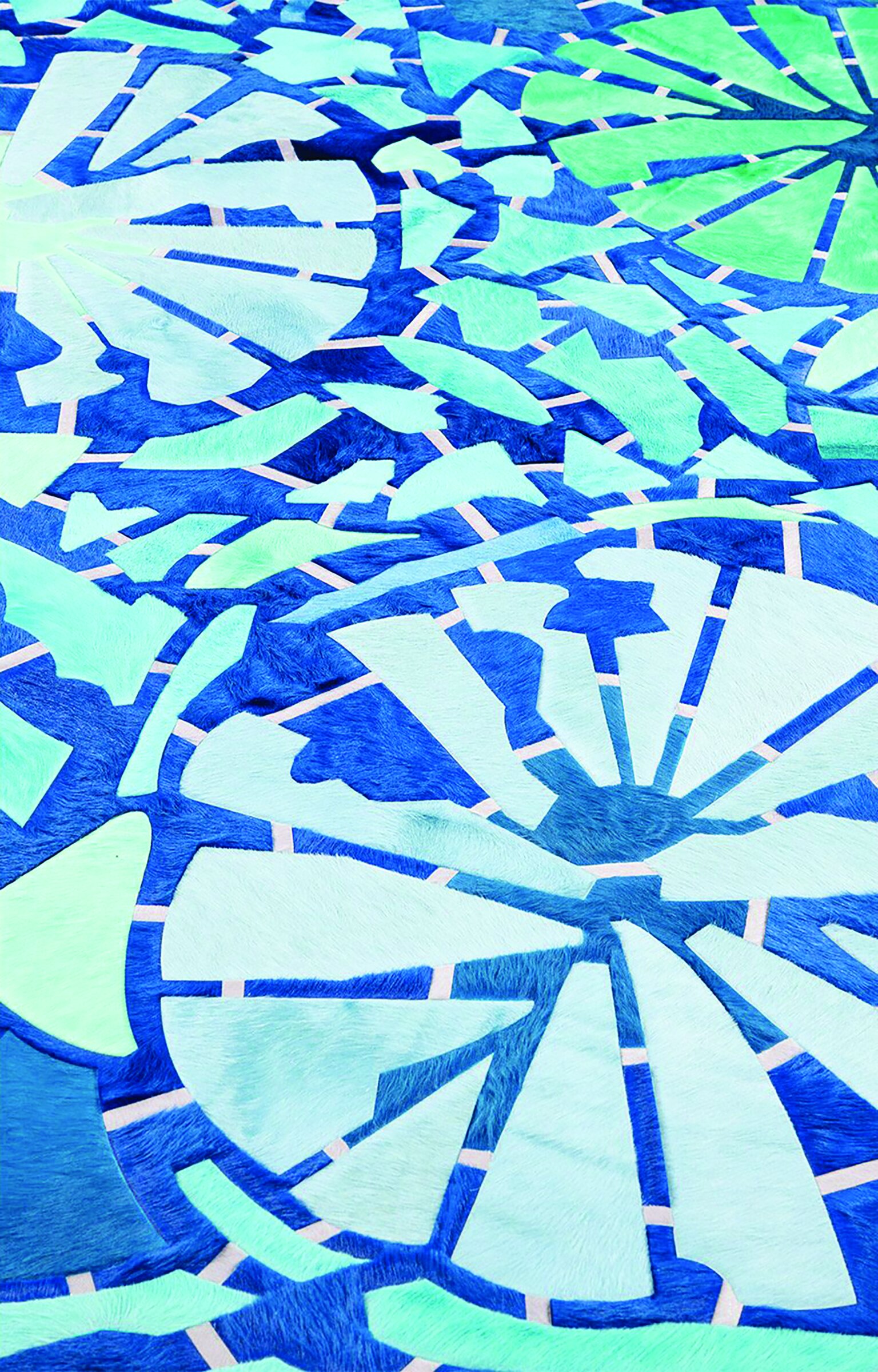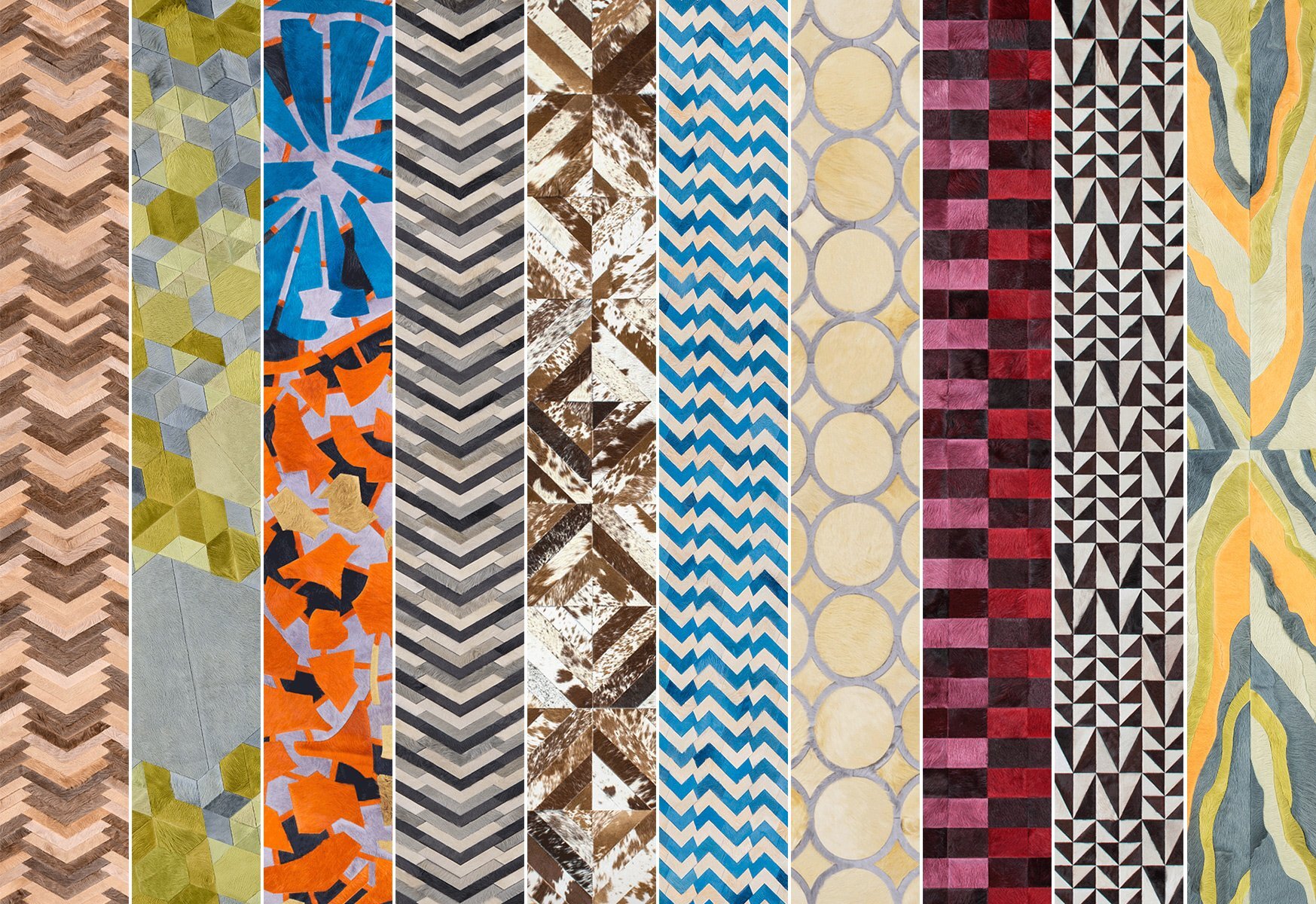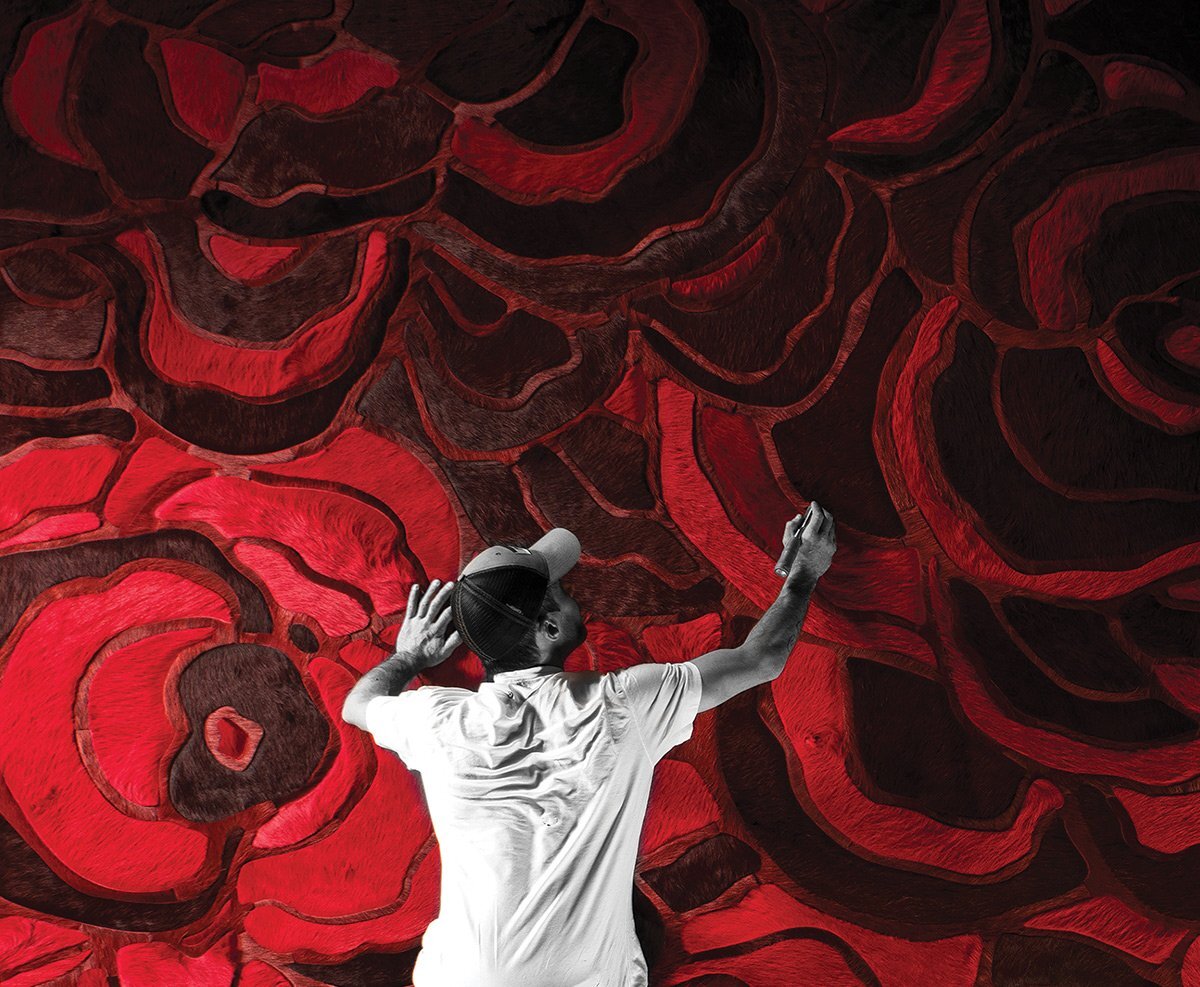Hide Art: The Bespoke World of Kyle Bunting
With a mantra of, “any size, any shape, any color,” the designer approaches rug design as a blank canvas, ready to bring his clients’ visions to life.
Meet Kyle Bunting—an innovative rug designer beautifully redefining how hide is used for interior applications. From vibrantly bold to subtly chic, Kyle incorporates elegant Italian hide into decorative pieces of art with an added bonus of comfort. Based in Austin, Texas, Kyle is constantly creating new pieces with his team of contributing designers. With a mantra of, “any size, any shape, any color,” the designer approaches rug design as a blank canvas, ready to bring his clients’ visions to life. Here, we chat with Kyle about his biggest inspiration, his favorite installation, and what a day in the life of a rug designer really looks like.
Tell us how you got started and why you chose to work with hides.
The business is 20 years old this year. I got into the design business after being in television and media for many years. When I bought my first place and hired an interior designer, I became enamored with the design business. To me, it was dimensional creativity, and it reminded me of the television business because it was very dynamic. You have interesting, creative people dealing with psychology, logistics, colors, and palettes. It’s a unique category of art. I knew I wanted to be in the business and do something special.
One night I woke up in the middle of the night and remembered that, in Texas in the late ’70s, my dad had bought many hides, and he would cut them into pieces and make them into tabletops and art pieces. One time a customer came in and said, “This is very beautiful, what you do, but is there any way you can make a rug for me?” So my dad figured out a way to make two rugs for his client, but he never made more. In fact, he never made any rugs again until August of 2001, when I, then living in San Francisco, remembered his rugs. So that is where the idea came about. “What if we do custom decorative carpets for designers that are very chic, high-end, couture, and highly artistic and sell them to designers and architects, but we make them out of hide?”
I saw the potential at that moment, but nobody else saw it. Even my dad thought, “That’s a great idea! Maybe you will make one or two per month in the garage,” but I told him, “I have a bigger idea.”
We consider your rugs magnificent works of art. From concept to creation, walk us through the design process.
We create beautiful decorative carpets that just happen to be made in hide. Our company works with interior designers and clients to bring their ideas to life. We help designers be successful for their clients, and we collaboratively create something beautiful. The designer understands the space and the client’s needs, and our job is to fit those needs. Designing is altogether a process that happens based on the relationship with the designer and bringing our ideas to improve the design.
Once the size, color and patters are defined, a wildly complicated yet simple process begins. We use a drawing of the final design to determine what colors are going to be used, how they will be cut, and where the will be placed. Each piece is then numbered. Then it is a matter of searching our inventory to find materials that match the size and hues of the pieces and looking through what is left over from previous jobs in a way that is not only creative but is sustainable in that we are using our materials efficiently.
Once the pieces of hides are selected and numbered according to their location on the design, we have the rug assembled according to the design template. There is a lot of organizational structure behind making a rug. We pay special attention to grain, quality and hair direction during assembly of the pieces to create some movement and dynamism. Finally, we cut the edges meticulously and paint them. We then photograph the pieces for marketing and archiving purposes. Depending on the size, the scale and the complexity of the project, the process can take a couple of days or, for complicated designs, two months.
What are the advantages of hides versus other materials?
Hide is just the material that we happen to use to make our work very interesting and beautiful. We double and triple saturate the dyes so that the colors are vibrant. We also use Italian hide, which is the highest quality you can find. An advantage of hide is that it has a tactile, interesting way of playing with light that is exciting to look at. It is also very durable. It is soft on your feet, yet stains are very easy to manage.
Have you expanded your product lines?
We are predominantly a decorative carpet for residential interiors; residential is 80% of our business. The rest is boutique commercial work like offices, restaurants, bars and hotels. Most of our commercial business is vertical—wall coverings, art pieces and murals. We also sell our hides to designers for upholstery for chairs, benches and other furniture items.
What is your most popular rug?
All cream carpet - monochromatic white hides. They are what we have done most of since I started doing rugs, and it is still probably 20% of the business. What is interesting about them is that the aesthetic is very compelling and attractive. Hide is the only thing you can use that gives you that pale creamy aesthetic without having to clean all the time. If you did a white rug in wool, everything would show.
Who has been your biggest inspiration?
My biggest inspiration has been my father Jim Bunting, who passed away in December of last year. My father created this idea and nurtured it into a small little thing, but he had a completely different line of work. But when I asked him, “I have this idea, would you mind if I ran with it?” he said “I would be thrilled, but I am only going to ask you for one thing…I am going to ask that you give it everything you have and never give up.”
To have been raised with an entrepreneurial background, where my dad told me that I could do anything that I wanted if I put my mind into it, was very inspiring to me. His entrepreneurial experience was incredibly important, and his love, encouragement and support through anything I wanted to do are what led me to where I am today.
I remember the time when I told him, “My pink, purple and orange rug is on the cover of Architectural Digest in Tommy Hilfiger’s living room! He shook his head and said, “I did not see what you saw, but this is unbelievable. Look what you have created!”
Tell us about your favorite installation. We were hired by an interior designer in Los Angeles to create a custom hide rug that was going to be installed in Saudi Arabia in a private, women-only spa. The designer said “I want to work with you. But the rug needs to be there in two months and it needs to be very beautiful.”
The rug was to be 950 square feet and laid into a concrete indentation that was half an inch deep and had already been poured. The designer emphasized that it had to fit perfectly into the space.
It was proof of some of the critical demands of the business and of the complicated development processes in our work. The engineering of the project was very complex, it was a logistical issue to get it shipped because of the rug’s size, and there were time constraints - we only had a couple of months to pull it off. Internally, we had to find a way in production to have the space to make something that big and be able to cut all the panels and move them all around as needed.
It has been my favorite project because it showed that every part of the business and the people on our team could all work with the client and our partners to fulfill what was needed, and we managed to deliver it with flying colors. It was a turning point in many ways.
Tell us about a typical day with Kyle Bunting.
I wake up early, work out quickly every morning, eat light and fly out the door. If I am not at the office and with my team by 8 a.m., I am not in Kyle’s happy place.
How does it feel like to walk on a Kyle Bunting rug?
My friend Cindy Allen, who is the editor of Interior Design Magazine, said it best, “It gives you happy feet.” I think I could not have said it better myself.
How did you meet Jennifer Welch? And how do you believe your styles align?
In my business, it is our responsibility to introduce ourselves to talented interior designers like Jennifer Welch and inspire them with what we can do so that we can develop a relationship and collaborate as much as possible. Jennifer discovered our line and started using our product, so I reached out and wanted to get to know her, and we just hit it off right away.
I believe our styles are similar in a way that we have a very diversified and eclectic approach to design. She is one of the best. Our personalities really connected and we formed a very special relationship. I believe we both saw how to make things and manage the business and assist one another; we also see things very similarly. We have an alignment of communality. Also, our diabolical sense of humor probably helps!
What does the future look like for Kyle Bunting?
What we do is very special. We are in the luxury business but our product is also very artistic. It is also very comforting and useful in that there is a practically to it. It’s luxurious, it’s purposeful and it’s artistic. We are just getting started telling the world what we can do, and I can’t wait to see what we do in the next 20 years.
What is your LUXIERE?
Luxiere to me is being genuinely, wholeheartedly loved and cared for. Tell me what feels better than that?







